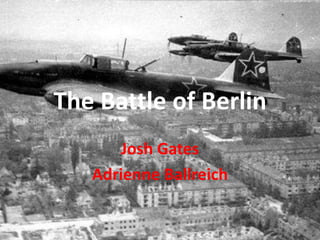
The Battle of Berlin: A Devastating Clash
- 1. The Battle of Berlin Josh Gates Adrienne Ballreich
- 2. Preparing for Battle Approximately 2.5 million Soviet troops led by Georgy Zhukov approached Berlin in early April, 1945; fighting began soon thereafter. Other Allied forces had been steadily approaching Berlin and bombing the city, but Stalin urged the Red Army to charge across Eastern Europe. This resulted in the death of a number of Soviet soldiers. Due to fear of Russian retribution, the elderly and members of the Hitler Youth aided Nazi forces in battle in an attempt to fend off the Soviets.
- 3. Hitler in Hiding Adolf Hitler remained in Berlin, both to boost Nazi morale and because there was no place left for him to go. He and his staff hid in an underground bunker below the city. Ironically, Hitler ordered the S.S. to hang any boys that were found hiding instead of fighting.
- 4. The Battle Began on April 16, 1945 One of the most intense battles in history Hand-to-hand combat broke out on the streets. Soviet tanks roamed the streets, destroying any buildings from which they were fired upon. The city soon fell to ruin.
- 5. Destruction and Starvation German families were forced to live in hiding inside the basements of buildings. Starvation became a serious problem because Russian forces deliberately destroyed grocery stores. At night, women would sneak out and salvage food from the gutters.
- 6. Soviet Abuse The Red Army imbibed the large store of alcohol found in Berlin. The soldiers were needlessly cruel and brutal to the city’s people. Soviet soldiers entered the city and raped over 100,000 German women. Russians looted German banks. Moscow officials originally denied these claims, but recent proof has been found.
- 7. Hitler’s Suicide On April 30, Hitler married his mistress, Eva Braun. He ingested cyanide and shot himself Before his death, Hitler ordered his men to burn his body afterwards; he did not want to be publicly displayed like fellow dictator Benito Mussolini.
- 8. Soviet Victory On May 2, the German parliament fell, and Berlin went under Soviet control. Vans drove through the streets, announcing a cease-fire on both sides. The elderly and Hitler Youth that fought in Berlin were imprisoned in Soviet labor camps Germany surrendered on May 7.
- 9. Statistics Germany: 1,000,000 soldiers 10,400 artillery 1,500 tanks 150,000 casualties Soviet Union: 2,500,000 soldiers 41,600 artillery 6,250 tanks 80,000 casualties
- 10. Russian Motives The Red Army came upon Berlin so suddenly partially due to a general distrust of the West. Stalin pushed for the invasion of Berlin to retrieve Germany’s nuclear material. It is estimated that the Soviets retrieved three tons of uranium oxide. Russian scientists needed this material to continue with their nuclear research.
- 11. Effects of Battle The German defeat at Berlin brought an end to the Third Reich and ultimately, World War II. Berlin, and the rest of Germany, was split into four sectors. Each sector was controlled by the Soviet Union, Great Britain, the United States, or France. This separation led to the political and social conflicts concerning the Berlin Wall.
- 12. Bibliography Remme, T. (2009). The Battle of Berlin in World War Two. Retrieved from http://www.bbc.co.uk/history/ worldwars/wwtwo/berlin_01.shtml. The Battle for Berlin. (2010). Retrieved from History Learning Site database. The Battle of Berlin: January-May 1945. (2007). Retrieved from The World War II Multimedia Database. von Schwanenfluegel, D. (2002). The Fall of Berlin, 1945. Retrieved from Eyewitness to History database.